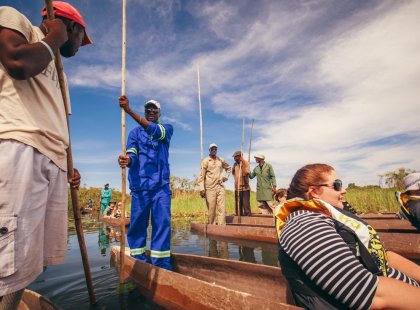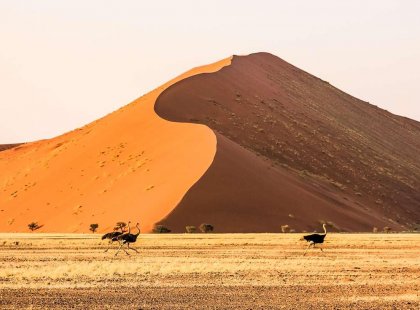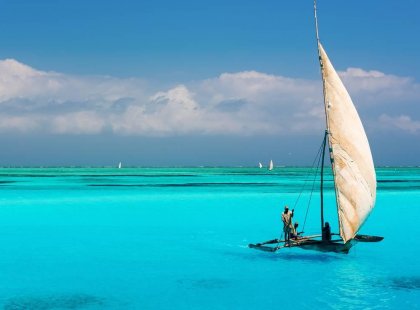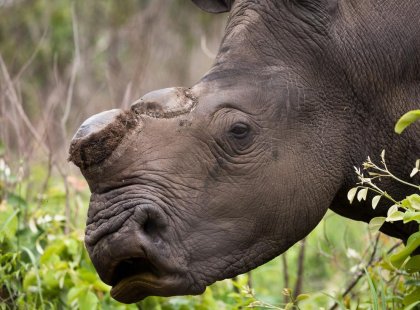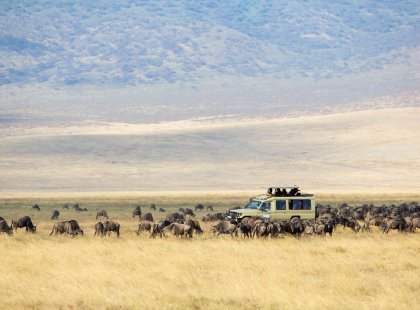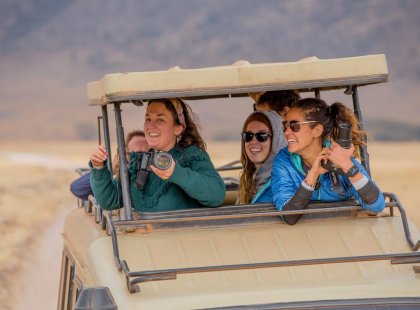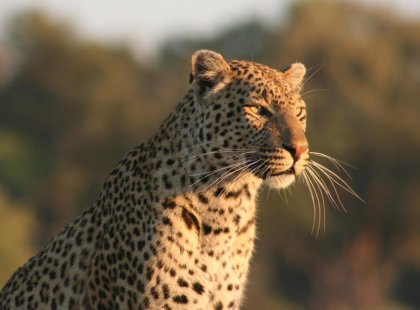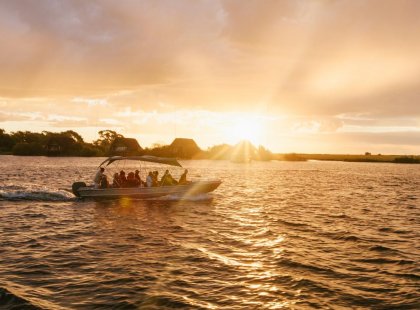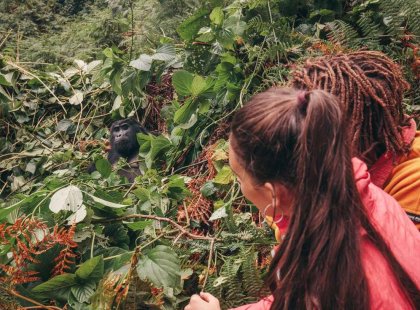Africa Encompassed Southbound
63 days
From
$ 9655
Duration63 days
Discover the best of Africa, from Kenya to South Africa. Want Africa with the lot? That's exactly what you'll get on this epic adventure across ten countries. Get breathtakingly close to animals more often seen in zoos and nature documentaries, from endangered mountain gorillas and lumbering elephants to ferocious lions and tiny dik-dik antelope. Along the way, meet people from a range of cultures and communities: Zanzibar spice growers, Lake Malawi fishermen and San people. This trip will leave you humbled and amazed by the breadth of life and culture, and the beauty of nature, on this ancient and spectacular continent.
-
Duration: 63 daysService level: Basic
-
Starts in: NairobiPhysical Grading: Average
-
Ages: 15+
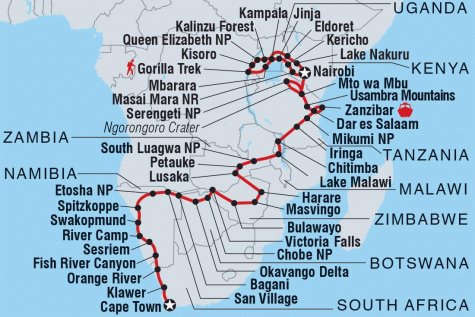
Itinerary
Day 1: Nairobi
Start place: Nairobi
Jambo! Welcome to Kenya. Your Africa adventure begins with a welcome meeting at 6pm. Please look for a note in the hotel lobby or ask reception where it will take place. If you can't arrange a flight that will arrive in time, you may wish to arrive a day early so you're able to attend. We'll be happy to book additional accommodation for you (subject to availability). If you're going to be late, please inform the hotel reception. Have your insurance details and next of kin information available for collection at this meeting. If you have the time, soak up the cosmopolitan atmosphere of Nairobi. There are plenty of good bars and restaurants, while markets and shops have most things you could want or need, as well as various arts and crafts from the region. There's also the National Museum of Kenya, the Karen Blixen Museum (author of Out of Africa), or Bomas of Kenya (displays of traditional homesteads of several Kenyan tribes) open for exploration.
Notes: Unfortunately petty crime has become fairly common in Nairobi and recently arrived visitors to the capital can often make for tempting targets. Your trip leader will verse you in a few worthwhile precautions at the welcome meeting. Some top tips are to get local advice on where to walk, keep valuables in a neck wallet or money belt or leave them secure in your hotel, and to not leave belongings unattended on chairs or the floor. Stay aware even when inside, as thieves and pickpockets have been known to operate indoors as well. There's no need to be paranoid, but appearing vigilant is a great deterrent to would-be thieves.
Notes: Unfortunately petty crime has become fairly common in Nairobi and recently arrived visitors to the capital can often make for tempting targets. Your trip leader will verse you in a few worthwhile precautions at the welcome meeting. Some top tips are to get local advice on where to walk, keep valuables in a neck wallet or money belt or leave them secure in your hotel, and to not leave belongings unattended on chairs or the floor. Stay aware even when inside, as thieves and pickpockets have been known to operate indoors as well. There's no need to be paranoid, but appearing vigilant is a great deterrent to would-be thieves.
Day 2: Lake Nakuru National Park
Take in spectacular views of the Rift Valley, Lake Naivasha and Elementaita on the drive north-west to Lake Nakuru National Park, situated in the heart of the Great Rift Valley. The drive will take approximately 3-4 hours. Arrive in time for a short evening game drive along the shore of the lake. Your camp tonight is located inside the park and has flush toilets and showers. Accommodation upgrades and WiFi are not available.
Lake Nakuru National Park is a small and compact area based around a lake that makes a great location for spotting wildlife. Along with the other members of the Big Five, Lake Nakuru harbours many rhinos and will be the best chance to get a great picture of these magnificent beasts.
Lake Nakuru National Park is a small and compact area based around a lake that makes a great location for spotting wildlife. Along with the other members of the Big Five, Lake Nakuru harbours many rhinos and will be the best chance to get a great picture of these magnificent beasts.
Meals: B, L, D
Day 3: Eldoret
Rise early this morning for tea or coffee before going back into the park for a morning game drive. Return to camp for brunch before driving north-west to Eldoret, one of Kenya's fastest growing towns (approximately 5-6 hours.). Due to its high altitude, the town is an ideal training ground for middle and long distance athletes and is home to some of Kenya's most famous runners. Your campsite is located before Eldoret town. It has basic flush toilets and showers, with upgrades available.
Meals: B, L, D
Day 4: Kampala
Today you will leave Kenya behind and cross the border into landlocked Uganda, travelling on to its capital city, Kampala (approximately 8 hours, though it could take longer depending on border crossings). With a population of over 30 million, Uganda is one of the five countries that make up the East African Community. It's a country of great cultural diversity and in recent years has been one of the most progressive in the region in terms of health education relating to HIV. As today is a long travel day, take a break from setting up camp with a stay at a hotel.
Meals: B, L, D
Day 5: Kalinzu Forest
Travel to Kalinzu Forest National Park (approximately 9 hours). Some of inhabitants include chimpanzees, black and white colobus, baboon, red-tailed monkey, both blue and red duiker, bushbuck, waterbuck, giant forest hog, buffalo and elephants.Your camp tonight has basic facilities with no upgrades available.
Meals: B, D
Day 6: Queen Elizabeth National Park
Take the optional excursion of visiting the Chimpanzees of Kalinzu Forest this morning or enjoy the sounds of the forest from the comfort of your tent. More closely related to humans than any other living creature, the chimpanzees are a delight to watch as they squabble and play in fruiting trees. Then take the short drive to Queen Elizabeth National Park. Once camp is set there's an option to take a boat cruise along the Kazinga Channel, well-known for pelicans, eagles and other wonderful birdlife, as well as its healthy population of hippos.
Meals: B, L, D
Day 7: Kisoro
Today, drive out of the Queen Elizabeth National Park on your way to the southwest tip of Uganda (approximately 6-7 hour drive). On this short game drive, cross your fingers and look out for elephants, buffaloes, Ugandan kobs and waterbucks. When you arrive at the corner of Uganda, where the border touches Rwanda and the Democratic Republic of Congo, you’ll be based in Kisoro, which provides access to seven different Gorilla groups – like in Mgahinga, Nkuringo, Rushaga and Nshongi. The camp here has basic flush toilets and showers, with upgrades available.
Meals: B, L, D
Day 8: Gorilla Trek
Joined by a local guide and trackers, climb through the rugged mountain terrain of Bwindi National Park to meet the eyes of these rare animals. No more than eight per day can visit any one habituated family and visits are strictly controlled to minimise the possibility of disturbance or transmission of disease to the animals. Tracking gorillas in the dense forest can sometimes be wet, muddy and uncomfortable. The terrain is by no means easy either, so it can be pretty strenuous and often humid, but the sheer thrill in coming across a habituated group of gorillas, dominated by a great male silverback, more than outweighs any difficulty. You need to be prepared and fit enough to walk up to 4 hours – up and down hill. You can usually get very close to the mountain gorillas, who are placid and gentle, and watching their movements is like seeing a mirror image of yourself. Be mesmerised as you watch them eat, sleep, groom and play – the giant silverback surveying the scene as the smaller ones laze in the trees or play like children. Your visit with the gorillas will last one unforgettable hour.
Meals: B, L, D
Day 9: Gorilla Trek
When you are waiting for, or have completed, your gorilla visit, your leader will provide you with options and ideas on how you can spend your free day in the area around Kisoro. You can head out on more rainforest hikes to see monkeys, take some nature walks, join a hike up Mt Sabinyo – one of five volcanoes located in the Parc National des Volcans – or perhaps make a visit to the Batwa community, indigenous to the Great Lakes Region and found throughout Burundi, Rwanda, Uganda and the eastern region of the Congo.
Meals: B, L, D
Day 10: Mbarara
Farewell the lands of the Gorilla and turn back towards the capital, Kampala. You’ll break up the journey at the pit-stoptown of Mbarara for the night (approximately 5-6 hours driving). There’s not much dressing up what is really just a stopping point, so spend the afternoon and evening relaxing at the camp, or maybe have a quick look around the town.
Meals: B, L, D
Day 11: Jinja
Today you'll continue your journey inland, travelling to Jinja (approx 7 hrs). Jinja is one of the highlights of any visit to Uganda, a riverside retreat at the source of the Nile but also the adventure capital of Uganda. Camp at a scenic riverside site with showers, flush toilets, WiFi and ATM access, and upgrades possible.
Meals: B, L, D
Day 12: Jinja
Located at the source of the Nile as it leaves Lake Victoria, Jinja is a place for the adventurer, the adrenaline junkie and the eco-traveller who wants to do something really worthwhile in a beautiful area. Maybe get active with some excellent white water rafting.
Meals: B, D
Day 13: Kericho
Farewell Uganda and begin the journey back to Kenya and Nairobi, stopping overnight at the town of Kericho (approximately 9 hours, including border crossings). Kericho sits at the edge of South- Western Mau National Reserve and is known for its vast tea estates. Tonight's camp is on the grounds of a hotel with upgrades available.
Meals: B, D
Day 14: Masai Mara National Reserve
This morning after breakfast, take the chance to visit one of the tea plantation the town is known for, learning about tea growing and production in Kenya. Afterwards, drive to the famous Masai Mara National Park (approximately 7 hours drive). The Masai Mara is the quintessential African experience, with sparse open plains, dramatic skies and the world's most iconic animals living within its boundaries. Explore this diverse environment and view a multitude of wildlife on an evening 4x4 game drive.
Meals: B, L, D
Day 15: Masai Mara National Reserve
Venture into the Masai Mara National Reserve for a full day's 4x4 game drive. You'll explore this diverse environment and most likely see a multitude of wildlife. An optional balloon ride over the Mara at sunrise is an unforgettable experience. If you have pre-booked this activity (see the 'Important Notes' section) you will be picked up before dawn and driven to the launch site for a safety briefing from your pilot. Then you will glide through the dawn, sometimes at tree height, which provides amazing photo opportunities. Sometimes you will ascend, getting an overview of the enormity of the plains and of the early morning movements of the teeming herds. After landing, you'll be treated to a bush breakfast, then be returned to your campsite.
Meals: B, L, D
Day 16: Nairobi
Continue on to Nairobi for a night in a hotel with ensuite, bar, pool and WiFi (310kms, approx. 6-7hrs).
Meals: B, L
Day 17: Mto Wa Mbu
Depart early for Mto Wa Mbu in your overland truck (approximately 8–9 hours). The trip includes a border crossing from Kenya into Tanzania, so be sure to have your passport handy. While you're on the road, there will be a stop at an ATM and a market or shop to stock up on any supplies you might need for the coming days. Arrive in Mto Wa Mbu and acquaint yourself with this delightful small village – it's a fascinating snapshot of small-town African life, situated well off the tourist trail. Tonight you'll stay at a campsite with flush toilets, showers and optional upgrades (subject to availability).
Meals: B, L, D
Day 18: Ngorongoro Crater / Serengeti National Park
Get up early, put your camping and personal gear into a six-person jeep and head out for an excursion into the Serengeti via the Ngorongoro Crater. Enjoy a safari in the crater, spending between three and four hours exploring this incredible, perfectly intact volcanic crater. Watch for black rhinos, lions, leopards, elephants, impalas, zebras and hippos. The crater floor offers excellent game viewing all year round (some 30,000 animals live here) and the photo opportunities here are unrivalled. Next it's on to the wide open plains of the Serengeti. Green after the rains, brown and burnt in the dry season, this is perhaps the quintessential image of Africa – the home of thousands of hoofed animals and fierce predators. Your campsite is within the Serengeti itself, so listen out for the sounds of nocturnal animals as you drift off to sleep. The camp is basic with limited running water and no upgrades or WiFi available.
Meals: B, L, D
Day 19: Serengeti National Park
Awake at dawn and embark on a game drive. You will head out while the animals are at their most active, then head back to camp for brunch at around 11 am. After spending the middle of the day relaxing, just like the animals do, head out again as the day begins to cool. You'll return from this second game drive in time for dinner.
There's also the option of a balloon ride over the park today (in place of some of the morning game drive). If you have pre-booked this activity (please see the 'Important Notes' section) you will be picked up before dawn and driven to the launch site. After a safety briefing, you will glide through the dawn, sometimes at tree height, which provides amazing photo opportunities. Sometimes you will ascend, getting an overview of the enormity of the plains and the early morning movements of the teeming herds. After landing, you'll be treated to a five-star bush breakfast, then be returned to your camp.
There's also the option of a balloon ride over the park today (in place of some of the morning game drive). If you have pre-booked this activity (please see the 'Important Notes' section) you will be picked up before dawn and driven to the launch site. After a safety briefing, you will glide through the dawn, sometimes at tree height, which provides amazing photo opportunities. Sometimes you will ascend, getting an overview of the enormity of the plains and the early morning movements of the teeming herds. After landing, you'll be treated to a five-star bush breakfast, then be returned to your camp.
Meals: B, L, D
Day 20: Serengeti National Park / Mto Wa Mbu
Rise with the sun and enjoy another game drive as you exit the Serengeti. Jump back into your overland vehicle and head for Mto wa Mbu. Once camp is set-up join the local community for a guided stroll around the farming areas, milling machine, and local homes and farmlands, before a local meal in town.
Meals: B, L, D
Day 21: Usambara Mountains
Prepare yourself for a long travel day heading for the Usambara Mountains (approximately ten hours). Stretch your legs during a brief supply stop in Arusha, then jump back in the vehicle and watch the ever-changing scenery, read your favourite book or get to really know your fellow travellers. Your base will be Lushoto, an old German colony and home to the Wasambaa people. This highland town sits at approximately 1400 metres and this evening you'll camp in the grounds of one of the oldest hotels in Africa.
Meals: B, D
Day 22: Usambara Mountains
Explore the beautiful Usambara Mountains, a lovely unspoilt area of Tanzania. Unlike the coast and the north, very few tourists visit this part of the country, so it has a freshness that can be hard to find elsewhere. As beautiful as the surrounding mountains and rainforests are, however, the real jewels here are the local people and villages. You'll experience some gentle hospitality on a visit to some of the small local communities. From your base, you will take a walk out to the gorgeous Irente viewpoint. It's best to pack some water and snacks in a day pack for this trip. On your way back, visit a local cultural project based at Irente farm and enjoy a picnic lunch.
Meals: B, L, D
Day 23: Dar es Salaam
Leaving the mountains behind, travel still further south to the coastal town of Kipepeo Beach in Dar es Salaam (380km, approximately 8-9 hours). Your camp at Kipepeo is by the beach, so make the most of it – perhaps take a stroll along the shore after you arrive and settle in. The camp is on the grounds of a hotel with upgrades usually possible
Meals: B, L, D
Day 24: Stone Town
Catch a ferry to the 'Spice Island' of Zanzibar. Filled with idyllic beaches, winding cobblestone alleyways and fragrant bazaars, Zanzibar has a colourful history – everything from slave traders to Arabian sultans and fruit exporters. The sight of traditional dhows sailing along the coast evokes what the island must have been like in Livingstone's day. The old part of Zanzibar's main city is known as Stone Town. The best way to see this exotic port town is on foot, exploring the markets, shops, mosques, palaces and courtyards. When the sun is setting, perhaps enjoy a sundowner from a bar overlooking the seafront, and a seafood curry at a local restaurant. Spend a night in Stone Town at a basic inn with double/twin-share rooms and access to WiFi.
Meals: B
Day 25: Zanzibar Northern Beaches
Check out of your Stone Town hotel and either drive to the spice plantations for your optional guided tour, or head directly to the perfect northern beaches. On the spice plantations guided tour you can learn all about the history of this town's renowned spice trade. You will also have the opportunity to touch, smell and taste various spices, such as cinnamon, vanilla and ginger. Sample some teas made with these spices too. After lunch here you will head to the northern beaches, where white sands and sparkling blue seas await, and reunite with your group. This is the Indian Ocean at its best.
Meals: B
Day 26: Zanzibar Northern Beaches
Enjoy free time in this beautiful archipelago today. There are many ways you can spend your day – perhaps talk to your leader for any recommendations they might have. Snorkelling in search of exotic fish is an excellent option. You might also like to feast on a sumptuous lunch of grilled local seafood, or simply relax in a hammock underneath a coconut tree with a good book.
Meals: B
Day 27: Stone Town
Return to Stone Town for a free afternoon and evening getting lost in the labyrinth of backstreets and alleys. Make the most of your last evening on the island by treating yourself to some fresh seafood and a sunset drink by the water.
Meals: B
Day 28: Mikumi National Park
Embrace an early start to catch a 7.30 am ferry to the mainland, then make tracks for Mikumi. It’s a six-hour drive to your first camp spot, but you’ll have plenty to look at along the way. Gaze out at vast plains dotted with baobab and tamarind trees and maybe catch a glimpse of some of the elephants, buffaloes, giraffes, lions and leopards that call the park home.
Meals: B, L, D
Day 29: Iringa
This morning there is a chance to wake up early and take a 2 hour 4x4 game drive into the Mikumi National Park. Perhaps get a better look at that lion or zeal of zebra you saw from the main road yesterday. Then drive to Iringa (approximately 5 hours). You will set up camp on the grounds of a farmhouse on the outskirts of this pleasant settlement. The area is filled with natural bush land which can make it a bird watchers paradise. Make the most of this rural setting by perhaps doing some stargazing before you retire for the night. Camp facilities, WiFi and accommodation upgrades are available.
Meals: B, L, D
Day 30: Chitimba
Enter Malawi and travel to your campsite at Chitimba (approximately 10–12 hours). Malawi, the 'warm heart of Africa,' is dominated by its lake, which covers almost a fifth of the country and provides a livelihood for many Malawian people. Fishermen, fish traders and canoe and net makers all ply their trade on Lake Malawi. A common sight is that of a fisherman in a bwato (a dugout canoe made from a hollowed tree trunk) fishing on the still lake at the break of day. Camp facilities, WiFi and upgrades are available tonight.
Meals: B, L, D
Day 31: Lake Malawi
Travel from Chitimba to Kande Beach on the shore of Lake Malawi (approximately 6 hours). There will be a chance to stop at a shop or market for any supplies you might need along the way. Enjoy a relaxing getaway from the commercialism and crowds with a few days on the lake's more peaceful beaches. Your campsite at Kande Beach is right on the shore of Lake Malawi. Accommodation upgrades are again possible (subject to availability). There is no WiFi, however.
Meals: B, D
Day 32: Lake Malawi
Enjoy free time to soak up your idyllic surrounds. You might like to participate in one of the many water-based activities on offer – ask your leader for a recommendation. As well as chilling out on the beach, make sure you take the opportunity to meet some local Malawians – easily some of the friendliest people in Africa.
Meals: B, L, D
Day 33: South Luangwa National Park
Journey through southern Malawi and enter Zambia, continuing to South Luangwa National Park (approximately 9–10 hours). There will be border crossing formalities on the way, and a chance to stock up on goods at a shop or market and visit an ATM. The concentration of animals around the Luangwa River and its lagoons is some of the highest in Africa. Take in the beautiful scenery and the abundance of game, watching out for colourful birds and herds of elephants. Your camp tonight has flush toilets, showers and WiFi. Upgrades are also offered (subject to availability).
Meals: B, L, D
Day 34: South Luangwa National Park
Rise early for an exhilirating morning game drive in a 4X4, then head back to the camp for lunch (as this is the hottest part of the day) and then perhaps return to the park for an optional game drive at night. A village walk is another good option, if you'd like a snapshot of daily life in the local community.
Meals: B, L, D
Day 35: Petauke
Head further south to Petauke (approximately 6 hours). The camp tonight has facilities, WiFi and upgrades (availability dependent).
Meals: B, L, D
Day 36: Lusaka
Head for your camp just south of Lusaka city (approximately 6 hours). Arrive, stretch your legs and take a stroll to discover this cosmopolitan yet traditional town. Though it's fast developing, Lusaka retains a strong African feel, and the locals are warm and friendly. Your camp tonight has facilities, a pool and upgrades available. WiFi is not available at this location.
Meals: B, D
Day 37: Harare
Travel to Harare today (approximately 8–9 hours). The first part of your journey takes you to the border with Zimbabwe. After formalities, enjoy a nice scenic drive of 60 kilometres or so, then continue to Harare. There will be a chance to stock up on whatever you need at a market or shop and visit an ATM. Upgrades are available at camp; there is no WiFi, however.
Meals: B, L, D
Day 38: Great Zimbabwe Ruins / Masvingo
Drive the short stretch to Masvingo (approximately 5–6 hours). This colonial settlement – the oldest in Zimbabwe – makes for the perfect base to explore the Great Zimbabwe Ruins. The ruined city, now a UNESCO World Heritage site, was first constructed in the 11th century. It's thought to be the former royal palace of the Zimbabwean monarch. Spend a few hours exploring this intriguing site before heading off to camp. Your campground in Masvingo has shared facilities, with upgrades and WiFi available.
Meals: B, L, D
Day 39: Bulawayo
Travel to Bulawayo (approximately 5–6 hours). Known locally as the 'City of Kings', Bulawayo is Zimbabwe's second largest city. There is some impeccable colonial architecture to take in here. Enjoy free time this afternoon to explore town - a 10 minute walk from the campsite. You might like to browse some local markets or chat with the locals. The Natural History Museum and National Art Gallery are also worth checking out. Tonight you will stay in a campground with shared facilities. Upgrades and WiFi are available.
Meals: B, D
Day 40: Bulawayo
Perhaps get up early and take the option to visit Matobo National Park. Home to a significant population of black and white rhinos, this optional activity gives you the unique experience to track these magnificent animals on foot. Here there will also be the chance to spot other game (the park is home to klipspringers, leopards, warthogs and springhares among many others). while learning about the various local plant and trees, wild pear and paperbark among them. This impressive wildlife park is also the site of the grave of Cecil John Rhodes, the founder of Rhodesia and the De Beers diamond company. The Matopos area has great spiritual and cultural significance to the local people, and there are many sites within the park where important ceremonies still take place.
Meals: B, L, D
Day 41: Victoria Falls
Depart Bulawayo and make the six-hour drive towards Victoria Falls. Stretching 1.6 kilometres wide and falling 108 metres into a narrow gorge below, the falls for which the area is named are truly a sight to behold. Although a visit to the falls themselves is optional, it is highly recommended. The entrance fee to the falls is not included in the price of this trip as groups are required to tour the site with a local guide, and we feel that seeing these waterfalls for the first time should be an uninterrupted sensory experience. In the wet season, the spray created from this feat of nature can rise 400 metres and can often be seen from kilometres away. It's no wonder that the local name for Victoria Falls is Mosi oa Tunya, or the 'smoke that thunders'. Though dry season travellers should not despair! You’ll get an unobstructed view of the falls and the chance to see the islets in the river below. Your leader will take you to a local activity centre where a range of activities will be on offer. We have not risk assessed all activities and only those listed in our trip notes are recommended for safety reasons. It is against company policy for leaders to facilitate the booking of any activities that have not been risk assessed or do not adhere to our company’s Responsible Travel policy and ethos. This includes organising transport to and from these activities in our vehicles. If you are interested in the Optional Helicopter flight (12 minutes or 25 minutes) we endorse the following operator only: Zambezi Helicopter co CAA Zimbabwe. Tonight's campground is an ideal base, centrally located in the town of Victoria Falls. Upgrades and WiFi are available.
Meals: B, L
Day 42: Victoria Falls
Spend a free day by Victoria Falls, perhaps getting involved in the optional activities on offer.
Meals: B
Day 43: Victoria Falls
Today is another free day to enjoy the many activities on offer. Or perhaps visit the falls again with your new group members.
Meals: B
Day 44: Chobe National Park
This morning is free for you to continue enjoying all that Victoria Falls has to offer. Afterwards, travel to Chobe National Park in Botswana (approximately 2–3 hours) via the Victoria Falls Wildlife Trust, one of The Intrepid Foundation projects. Here you can learn about the rescue and rehabilitation of wildlife, human-wildlife conflict and the trusts role in anti-poaching. There may also be a chance to meet any rescued or orphaned wildlife currently in their care.
Botswana's first national park is famous for its high concentration of elephants, so keep an eye out for them. They can often be seen swimming in the Chobe River. Your camp, located outside of the park, has flush toilets, showers, Wi-Fi, ATM and optional upgrades.
Botswana's first national park is famous for its high concentration of elephants, so keep an eye out for them. They can often be seen swimming in the Chobe River. Your camp, located outside of the park, has flush toilets, showers, Wi-Fi, ATM and optional upgrades.
Meals: B, D
Day 45: Chobe National Park
Enjoy an early-morning game drive. Adventuring through the park, you will have the opportunity to get up close to the wildlife. With some luck you will spot a variety of animals and any number of exotic birds. As well as the Chobe icon, the elephant, the river also attracts hippos and crocodiles; the latter like to sun themselves by the water's edge. Cheetahs also come down for a drink. The birdwatching is excellent here too – look out for eagles, kingfishers and marabou storks, among hundreds of other species. In the afternoon perhaps take an optional cruise down the Chobe River – one of the best ways to enjoy the park's animals.
Meals: B, L, D
Day 46: Bagani
Today you will enter Namibia, driving from Kasane to Ngoma Bridge, and on to your camp at Bagani (approximately 7 hours). Bagani is a small, friendly town with some good hiking trails along the river. There are also plenty of nice spots in which you can simply relax and soak up the ambience. This area is the homestead of the local Mbukushu kings. You will have the opportunity to stop at an ATM and a market or shop today. Your camp has flush toilets, showers and Wi-Fi. Upgrades are also available (subject to availability).
Meals: B, L, D
Day 47: Okavango Delta
Drive across the border into Botswana and head south along the Okavango Panhandle (the narrowest part of the delta) to Seronga. Here you'll leave your vehicle and join your transport for the journey into the delta (approximately 4 hours). Take a boat across the swamps to Gao Island to meet your mokoro team and start exploring the Okavango Delta with them. Each mokoro (small dugout canoe) takes two people and is poled along through the waterways by a local tribesman. Reeds and lily pads line the streams, and birds startled by the mokoros rise out of the long grasses. Punting along, you'll hear hippos occasionally piercing the peaceful atmosphere with their grunts. On the first night here you'll camp on an island well away from civilisation.
Meals: B, L, D
Day 48: Okavango Delta
Continue your trip around the delta and then return to Gao Island before heading to the relative civilisation of Umvuvu Camp. This camp usually has hot showers, and there's a small bar at which you can relax and perhaps enjoy a refreshing sundowner. Today there is an option to take a nature walk with your guide. This is a great chance to discover the beautiful natural surrounds, gain some insight into the history of the local area and take some photos.
Meals: B, L, D
Day 49: Bagani
Return to Bagani to camp for the night. Various boat trips, fishing trips and guided hikes are possible from Bagani, so if you're feeling active, get out and make the most of it. Those who are feeling bold might even be able to challenge the local kids to a soccer match – don't expect to win though! Retire to your camp in the evening and enjoy this welcome break from the road.
Meals: B, L, D
Day 50: Grootfontein
Drive to your camp situated 50km outside Grootfontein (approximately 7 hours). The town of Grootfontein, part of the Otavi Triangle, tends to get very green in the warmer months but dries out markedly in the winter. If it's springtime, you'll likely see jacarandas in bloom. There is the possibility of an accommodation upgrade here, but wi-fi will not be available.
Meals: B, D
Day 51: Grootfontein/San people
Embark on a 180-kilometre (112-mile) round-trip to visit the San people. The oldest inhabitants of Southern Africa, the San have lived in this region for at least 20,000 years. Listen to their stories and songs, and learn how those who still adhere to a traditional way of life emphasise the important of living in harmony with the environment.
Meals: B, L, D
Day 52: Etosha National Park
Travel about five hours to Etosha National Park. The park is home to a wide range of Southern Africa's wildlife, including all the big carnivores and five rare or endangered species: black rhino, Hartmann's mountain zebra, black-faced impala, roan antelope and the tiny Damara dik-dik. Game viewing in Etosha is relatively easy due to the man-made waterholes and the large, sparsely vegetated pans. The bushland surrounding the pans is difficult to see through, but there are enough clearings, pans and waterholes to usually allow for some sightings. Embark on an optional evening game drive here in the evening, then spend the night at Namutoni. Accommodation upgrades are on offer here.
Meals: B, D
Day 53: Etosha National Park
Enjoy a full-day game drive in Etosha National Park. Namibia has protected its game reserves against poaching, which means significant numbers of elephants, antelope and other herbivores reside here. The park is also home to some 340 species of birds – keep an eye to the sky where you might spot a soaring eagle. Tonight you will stay at the particularly spectacular Okaukuejo Camp. The camp overlooks a floodlit waterhole visited by many different species throughout the day and night. Upgrades are not available at this location tonight.
Meals: B, L, D
Day 54: Spitzkoppe
Travel to the mountain of Spitzkoppe, the 'Matterhorn of Namibia' (approximately 9 hours). The wild lands around this superb granite peak are some of Namibia's most stunning. The mountain itself is 700 million years old and 1987 metres/6519 feet high. Although you shouldn't try to climb to the top, there are some excellent hikes to do in the area, which is rich in plant life and has some bush paintings to be found. Be sure to look out for the sunset from your bush camp this evening – the landscape is known to take on dazzling hues of orange and red.
Meals: B, L, D
Day 55: Swakopmund
Continue to the town of Swakopmund (approximately 5-6 hours). Be dazzled by the sight, sound and smell of thousands of olive-coloured seals on the shores of Cape Cross while you're travelling up the eerie Atlantic Coast. You'll be able to stop along the way to access an ATM or market if you need some supplies. Your accommodation for these nights is a simple, cosy lodge. Wi-Fi is not available at this location.
Meals: B, L
Day 56: Swakopmund
Surrounded by the massive dune fields of the Namib Desert on three sides, and the Atlantic Ocean on the other, Swakopmund is an example of the extraordinary German culture that's found in all major settlements in Namibia. It's worth wandering around town to admire the beauty of the Germanic architecture and take advantage of some excellent souvenir shopping.
Day 57: Swakopmund
Today is another free day to enjoy this fun beachside town. If you're after a dose of history and culture, you can stop in at the lighthouse and visit the Swakopmund Museum. Active types and thrill-seekers might like to take advantage of the many outdoor activities on offer – this town is the adventure-sports mecca of Namibia.
Day 58: Sesriem
Drive to Sesriem, your base for exploring the incredible Namib Desert region (approximately 6-7 hours). The most famous part of the Namib Desert is its vast dune fields, the most spectacular of which are found near the Sesriem Canyon. This canyon was formed when the Tsauchab River carved a gorge 30 metres into the gravel deposits about 15 million years ago. Now the river flows out to the dune fields that stretch for hundreds of miles up the coast, and dries up in a clay pan at Sossusvlei. The dunes are stunning, with magnificent burning tones created by the brightly coloured sands. These are the highest dunes in the world.
Meals: B, L, D
Day 59: Sossusvlei / Konkiep River
Wake up before dawn and scramble to the top of the dunes for a dramatic sunrise view across a vast sea of sand. The colour changes are simply incredible and provide a spectacular setting for your brunch. Afterwards you will jump in the back of a pickup truck for a trip to Sossusvlei, the incredible salt and clay pan just nearby (approximately 30 minutes each way). Enjoy some time to explore this incredible and mysterious desert oddity. Later, continue to your camp past the small town of Bethanie (approximately 6 hours). Your camp has basic facilities, with showers, flush toilets, Wi-Fi and optional upgrades.
Meals: B, L, D
Day 60: Fish River Canyon
Check out the town of Bethanie before heading further south, deeper into the vast desert lands of Namibia, drive towards Fish River Canyon (approximately 3-4 hours). At 500 metres deep and over 160 kilometres long, Fish River Canyon is one of the very largest canyons in the world. During the dry season, the river bed tends to dry out completely, leaving only a few puddles. In the wet season, after the summer rains, the river can turn into a spectacular raging torrent. At any time of year there are remarkable photographic opportunities here as we watch the color of the granite rocks change as the sun goes down. Note that upgrades and Wi-Fi are not available at your camp tonight.
Meals: B, L, D
Day 61: Orange River
Departing Fish River Canyon, travel to Noordoewer (approximately 5 hours). Pitch your tent on the scenic banks of the Gariep (Orange) River. Traditionally known as the Gariep River, the Orange River is the longest in South Africa, at 2200 kilometres/1367 miles. Its source is high up in the Drakensberg mountain range in Lesotho, and it flows into the Atlantic Ocean at Alexander Bay in South Africa. The Orange River is responsible for transporting diamonds and creating the deposits that can be found along the Namibian coast. Upgrades are possible tonight (subject to availability), though there is no Wi-Fi available.
Meals: B, L, D
Day 62: Western Cape
Depart first thing in the morning, heading to Klawer – a town named after the Afrikaans word for a wild clover blooming after rainfall. The surrounding countryside is beautiful. If there's time, you will have the opportunity to explore some of it – take a delightful walk around the nearby mountains and farms before retiring for the evening.
Meals: B, D
Day 63: Cape Town
Head to Cape Town (approximately 5 hours), where you trip ends upon arrival. With its stunning coastline, modern cityscape, nearby mountains and a plethora of nearby vineyards, this is one of Africa's most exciting cities. There's no accommodation provided for tonight, but this can be arranged – please enquire at the time of booking this trip.
Meals: B
Inclusions
Included
- Lake Nakuru - Overland Vehicle Game Drive
- Lake Nakuru - Morning Overland Vehicle Game Drive
- Queen Elizabeth National Park - Overland Vehicle Game Drive
- Bwindi National Park - Mountain Gorilla Permit & Trek
- Masai Mara - 4x4 Game Drive
- Tea plantation visit
- Masai Mara - Full Day 4x4 Game Drive
- Ngorongoro Crater - 4x4 Game Drive
- Serengeti National Park - 4x4 Game Drive
- Mto Wa Mbu - Village walk & market visit
- Irente - Lushoto hike & local lunch
- South Luangwa National Park - 4x4 Dawn Game Drive
- Masvingo - Great Zimbabwe Ruins guided visit
- Victoria Falls - Victoria Falls Wildlife Trust Visit
- Chobe National Park - Dawn 4x4 game drive
- Okavango Delta - Mokoro safari
- Okavango Delta - Nature Walk
- Grootfontein - San Bushman cultural experience
- Etosha National Park - Overland Vehicle Game Drive
- Cape Cross Nature Reserve - Cape Cross seal colony
- Sossusvlei - 4x4 Tour
- Sesriem - Sand dunes visit
- Fish River Canyon - Canyon entrance
-
Transport
Overland vehicle, 4x4 Safari Vehicle, Ferry, Minibus, Mokoro -
Accommodation
Camping (with facilities) (48 nights), Camping (with basic facilities) (4 nights), Bungalow (2 nights), Chalet (3 nights), Hotel (4 nights), Hotel with shared facilities (1 night)

